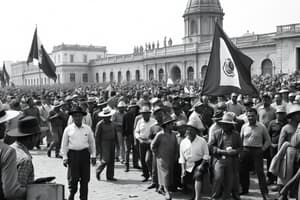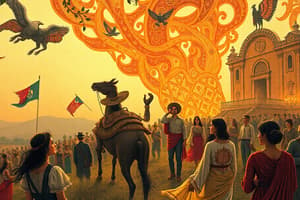Podcast
Questions and Answers
When did the Mexican Revolution begin?
When did the Mexican Revolution begin?
- 1900
- 1910 (correct)
- 1890
- 1920
How long did the Mexican Revolution last?
How long did the Mexican Revolution last?
- 5 years
- About a decade (correct)
- Less than 5 years
- Over 20 years
What aspects of Mexico did the Mexican Revolution reshape?
What aspects of Mexico did the Mexican Revolution reshape?
- Cultural and artistic developments
- Social, economic, and political landscape (correct)
- Educational systems
- Military infrastructure
What was the social structure in Mexico like before the revolution?
What was the social structure in Mexico like before the revolution?
Who suffered the most from poverty and social discrimination before the revolution?
Who suffered the most from poverty and social discrimination before the revolution?
What was the primary cause of widespread discontent before the Mexican Revolution?
What was the primary cause of widespread discontent before the Mexican Revolution?
What was the impact of Porfirio Díaz's regime on the rural and working-class Mexicans?
What was the impact of Porfirio Díaz's regime on the rural and working-class Mexicans?
How did the economic policies during Porfirio Díaz's rule affect the wealth gap in Mexico?
How did the economic policies during Porfirio Díaz's rule affect the wealth gap in Mexico?
What was the primary consequence of the foreign investment and modernization encouraged by Porfirio Díaz's regime?
What was the primary consequence of the foreign investment and modernization encouraged by Porfirio Díaz's regime?
What method did Porfirio Díaz use to maintain power?
What method did Porfirio Díaz use to maintain power?
What fueled the desire for political change and democratic governance during Díaz's regime?
What fueled the desire for political change and democratic governance during Díaz's regime?
What characterized Porfirio Díaz's dictatorship politically?
What characterized Porfirio Díaz's dictatorship politically?
Who challenged Porfirio Díaz in the 1910 presidential election?
Who challenged Porfirio Díaz in the 1910 presidential election?
Whose Plan de Ayala in 1911 called for land reforms and influenced the revolutionary agenda?
Whose Plan de Ayala in 1911 called for land reforms and influenced the revolutionary agenda?
Who led peasant armies in the south during the Mexican Revolution?
Who led peasant armies in the south during the Mexican Revolution?
Who challenged Porfirio Díaz in the 1910 presidential election?
Who challenged Porfirio Díaz in the 1910 presidential election?
Whose Plan de Ayala in 1911 called for land reforms and influenced the revolutionary agenda?
Whose Plan de Ayala in 1911 called for land reforms and influenced the revolutionary agenda?
Who led peasant armies in the north during the Mexican Revolution?
Who led peasant armies in the north during the Mexican Revolution?
Flashcards
Mexican Revolution
Mexican Revolution
A period of significant social and political upheaval in Mexico that lasted from 1910 to 1920. It resulted in major changes to the country's political, social, and economic structures.
Social Structure Pre-Revolution
Social Structure Pre-Revolution
A social system in Mexico before the revolution where a small elite of wealthy landowners and politicians held most of the power, while the majority of people, including peasants and workers, were impoverished.
Who was Porfirio Díaz?
Who was Porfirio Díaz?
A powerful figure in Mexican history who ruled Mexico for over 30 years (1876-1911). He ushered in an era of modernization and economic growth, but also oversaw widespread poverty and social inequality.
Causes of Discontent (Pre-Revolution)
Causes of Discontent (Pre-Revolution)
Signup and view all the flashcards
Effects of Díaz's Regime
Effects of Díaz's Regime
Signup and view all the flashcards
Negative Impact of Foreign Investment
Negative Impact of Foreign Investment
Signup and view all the flashcards
How did Díaz maintain power
How did Díaz maintain power
Signup and view all the flashcards
Who was Francisco Madero?
Who was Francisco Madero?
Signup and view all the flashcards
Who was Emiliano Zapata?
Who was Emiliano Zapata?
Signup and view all the flashcards
Who was Pancho Villa?
Who was Pancho Villa?
Signup and view all the flashcards
Land Reform
Land Reform
Signup and view all the flashcards
Social Justice
Social Justice
Signup and view all the flashcards
Political Change
Political Change
Signup and view all the flashcards
Impact of the Mexican Revolution
Impact of the Mexican Revolution
Signup and view all the flashcards
Legacy of the Mexican Revolution
Legacy of the Mexican Revolution
Signup and view all the flashcards
Study Notes
Mexican Revolution
- The Mexican Revolution began in 1910 and lasted for over a decade, reshaping the country's political, social, and economic structures.
Social Structure before the Revolution
- Before the revolution, Mexico's social structure was characterized by a small elite of wealthy landowners and politicians who held power, while the majority of the population, including peasants and workers, suffered from poverty and social discrimination.
Causes of Discontent
- Widespread discontent before the revolution was primarily caused by the regime of Porfirio Díaz, which maintained power through repression and fraud, leading to economic inequality and social injustice.
Effects of Porfirio Díaz's Regime
- Porfirio Díaz's regime had a devastating impact on rural and working-class Mexicans, who suffered from poverty, exploitation, and lack of political representation.
- His economic policies widened the wealth gap in Mexico, benefiting the wealthy elite and foreign investors at the expense of the working class.
Consequences of Foreign Investment
- The primary consequence of foreign investment and modernization encouraged by Porfirio Díaz's regime was the concentration of wealth in the hands of foreigners and a small elite, further exacerbating social and economic inequalities.
Díaz's Rule
- Porfirio Díaz maintained power through repression, fraud, and manipulation, characterizing his dictatorship as authoritarian and corrupt.
- His regime fueled the desire for political change and democratic governance, as the lack of political representation and civil liberties became increasingly unbearable.
Challengers and Revolutionaries
- Francisco Madero challenged Porfirio Díaz in the 1910 presidential election, sparking the Mexican Revolution.
- Emiliano Zapata's Plan de Ayala in 1911 called for land reforms, influencing the revolutionary agenda and shaping the revolution's social and economic goals.
- Pancho Villa led peasant armies in the north during the Mexican Revolution, while Emiliano Zapata led peasant armies in the south.
Studying That Suits You
Use AI to generate personalized quizzes and flashcards to suit your learning preferences.




